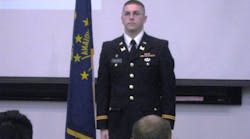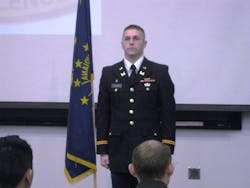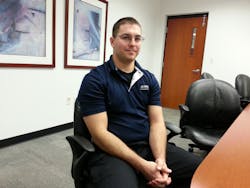This is the time of year when Bing Crosby’s ghost is summoned to repeatedly sing White Christmas. It’s also the time of year when the unemployed feel the bitter sting of their status a little sharper. And among the ranks of the unemployed there’s a certain subgroup for whom that sting takes on a bittersweet tinge when they hear Mr. Crosby croon this little phrase from a song in the movie White Christmas:
Nobody thinks of assigning him
When they stop wining and dining him
It seems this country never has enjoyed
So many one and two and three and four star generals
Unemployed.
Bing is singing the truth—not just about generals, but about veterans in general. According to the Council of Economic Advisers, the unemployment rate for recent veterans is 10 percent—which is higher than the rate for non-veterans in the same demographic group. The Washington Post reported that the population of veterans who have served since 9/11 stands at 246,000. The newspaper cites disability and lack of civilian work experience as two of the main reasons.
Another popular Christmas movie is It’s a Wonderful Life, in which a man gets to find out what life in this world would be without him. I know one company whose newly introduced lift truck might not have been the success it turned out to be without one particular veteran-in-the-making. His name is David Clayton, and he’s a production engineer at Toyota Industrial Equipment Manufacturing’s (TIEM) Columbus, Ind., manufacturing plant. He also happens to be a second lieutenant and platoon leader in the Indiana National Guard, so he’s in a unique position to demonstrate the skills a military leader can bring to a project like a new product launch.I met David a couple months ago when Toyota Material Handling opened its new headquarters on the same campus with the TIEM plant. My interest in talking with him was to kick off a series of profiles of veterans who’ve found employment in material handling and logistics. I asked him what drew him to military service and how that service prepared him for work in manufacturing.
David’s first inkling to enter military service came with 9/11, as it did for many who felt the call to protect their country from terrorism. David was in high school at the time and had plans to go to college—which he postponed so he could join the National Guard. He craved the discipline and structure military life offered and figured the experience would also prepare him to be a better student in college. So, in 2005—his senior year in high school—he enlisted in the 163rd field artillery unit in Evansville, Indiana.
When he finally entered college he did so through the Reserve Officers' Training Corps (ROTC) and his goal was to pursue an engineering career while he became an Army officer. While in college he also did an internship at Custom Resins in Henderson, Ky., an experience which he credits for teaching him about industry through the manufacture of nylon extrusions. Another formative experience was his first taste of industrial leadership, heading up a robotics engineering team for NASA’s Lunabotics Mining Competition. His team came up with a mining robot that excavated and deposited soil. This was in 2010—his fourth year of officer training. He was a cadet commander. In 2011 he received his commission as a second lieutenant and served as a platoon leader with the field artillery unit in Evansville for a year and a half until moving to Columbus to work at Toyota. What drew him to the world of material handling?“I took an industrial management and planning course in my final year in college,” he said. “’The Toyota Way’ was our course material and we learned process layout and how to make an overall plant layout functional. We looked at Toyota’s forklift business and some people from the company’s Princeton plant talked about their engineering opportunities and how their company runs. One of the people who was on my team for the robotics competition ended up working here in Columbus at TIEM and that led me to applying for a position after college.”
His military training was put to good use as a production engineer for the small parts welding group on the company’s new 8 Series heavy duty diesel lift trucks. This is where David honed the leadership skills achieved as an officer, and he intends to continue developing these skills in industry.
“I like to lead and after a few more years of doing design work I might get a supervisory position,” he told me. “Design is a passion, and part of this skill involves helping others get projects done. I like to look at a problem, and use my knowledge and abilities to create something that will either solve a safety problem or make a process easier to run. Many positions at this company will allow me to do these kinds of design projects.”
In the meantime he intends to recruit as many military buddies to this industry as he can.
“Many of them don’t know what to do next,” he said. “I ask if they have any interest in working in manufacturing because the comparisons between military and manufacturing are similar. In the military there’s a high level of discipline and respect for those above you and recognition that if you don’t follow directions there’s a high price to pay.”
He believes many veterans do well under a leadership chain of command and that their training to find the earliest point in that chain to get a problem solved would serve employers in any industry.
“The military offers good time management and problem solving skills, and the critical thinking and leadership capabilities that develop help suit veterans to industry,” Clayton said. “I know some who have served in the military for 20 years and are intimidated when they retire and worry that they don’t have the skills, but some can go right into the supervisory level. Once they’re trained they learn very quickly.”
Tim Hollkamp agrees. He’s manager of human resources for TIEM, and he has a valuable lesson for those employers reluctant to hire veterans because of the perceived challenges stated toward the beginning of this profile.
“We try to match the same hierarchy that the military has so when people like Dave come in there is a comfort zone and they can relate to that,” he says. “We use a local workforce development agency and go to job fairs and have found 35 veterans that way.”
I told a friend of mine who is an Army vet that I was going to profile veterans for a series in MH&L, and I asked him what I could include in it that would convince employers begging for engineering talent that veterans provided a good pool in which to dive. He cited the 14 leadership traits that he and his fellow soldiers are expected to memorize. I can’t think of a better job description for any employer:
BEARING
COURAGE
DECISIVENESS
DEPENDABILITY
ENDURANCE
ENTHUSIASM
INITIATIVE
INTEGRITY
JUDGEMENT
KNOWLEDGE
JUSTICE
LOYALTY
TACT
UNSELFISHNESS
If you know a veteran who's working in logistics or looking to work in logistics, let me know about him or her at [email protected]. More employers need to hear their stories.





